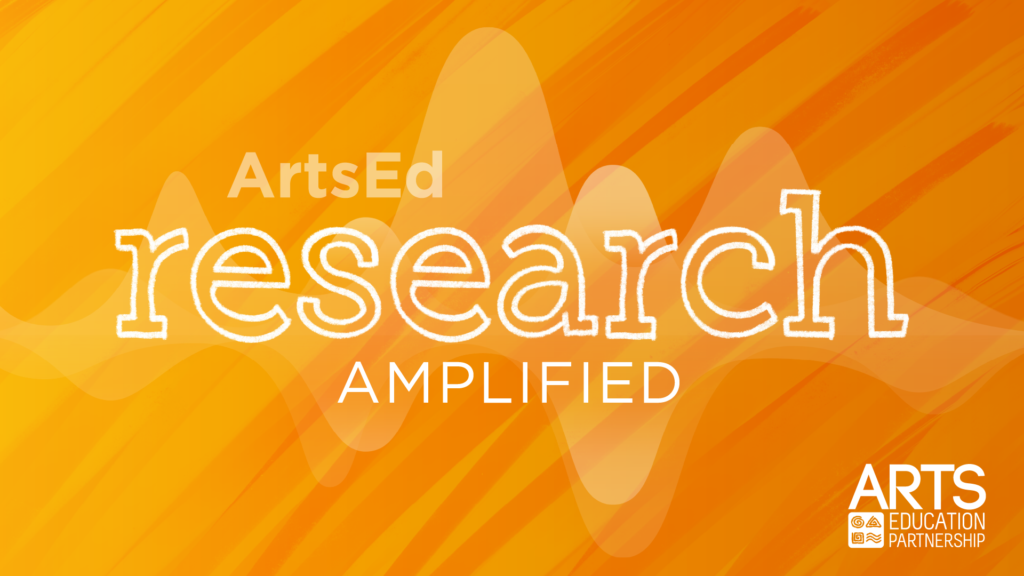Developing a Theory of Action for K-12 Arts Education and SEL Outcomes

What role do arts education programs play in children’s social and emotional learning (SEL) and development?
This is not a new question; social and emotional competencies have increasingly been acknowledged as an essential component of a well-rounded education with important implications for lifelong success. In turn, education researchers have increasingly paid attention to understanding how social and emotional outcomes can be developed, and school leaders have increasingly paid attention to developing these competencies in their students. Simultaneously, arts education researchers and practitioners have also begun to pay more attention to the role of arts programs in SEL.
In many ways, the increasing attention to the role of arts education programs in SEL is a welcome opportunity for arts education researchers, as it may represent the beginning of a shift away from the focus on the impact of arts education on more traditional academic outcomes. In the high-stakes testing environment that has dominated education for so long, most recent research on the impact of arts education tended to focus on how it impacts students’ performance on standardized tests. (Of course, none of these ways of talking about the value of an arts education focus on the importance of being educated in the arts per se, but that’s a conversation for another day).
So we were excited by the opportunity to contribute to this conversation. Thanks to a generous grant from the Spencer Foundation, Ingenuity and the University of Chicago Consortium on School Research launched a project aimed at developing a Theory of Action describing how arts education programs affect SEL among K-12 students. Our goal is to provide a research-based, conceptual framework for arts education practitioners seeking to facilitate SEL outcomes among their students. We aim to present a theory that is generalizable, plausible and relevant across various art disciplines and SEL outcomes, as well as accessible and useful to arts education practitioners. We hope to shine a light on the “black box” that too often marks arguments about how arts education contributes to SEL outcomes. We also envision the theory serving as a touchstone for future research on the relationship between arts instruction and SEL.
The project began with a deep review of existing research exploring the relationship between arts education and SEL outcomes. Our fieldwork — comprising a combination of interviews and focus groups with students, parents, arts teachers, teaching artists, administrators and experts in the field — is helping us understand how stakeholders think and talk about this topic. We have been ably supported by a steering committee of experts in various related fields, which we recently convened to share and collect feedback on our preliminary findings, and to help us plan for additional fieldwork and the finalization of our report in spring 2018.
So what have we learned so far? You’ll have to wait until Ingenuity releases the report to get the full story, but we can say that we encountered a wealth of passionate, thoughtful and ambitious people in the arts education sector that are eager for tools to help them contextualize their SEL-related work. What we’ve heard from these stakeholders has helped us envision this as a project that can enable practitioners to parse out educational practices and strategies that promote SEL outcomes. This framing has also helped us realize that practitioners and researchers focused on other education sectors, such as English language arts and STEM fields, may be able to learn from how arts educators already think about the SEL outcomes their work affords.
Stay tuned for our full report next spring!
This is a guest post by Steve Shewfelt and Jenny Nagaoka. Steve is director of data and research at Ingenuity, a nonprofit organization working to increase arts education access, equity and quality in Chicago Public Schools. Jenny is deputy director of the UChicago Consortium on School Research, which conducts research that identifies what matters for student success and school improvement.
UPDATE FEBRUARY 2020: Read the full report, “Arts Education and Social-Emotional Outcomes Among K-12 Students: Developing A Theory of Action,” here.
The Arts Education Partnership serves to communicate the power of arts in education, collaborate on new research and policy solutions, convene national experts and thought leaders and connect its partners and the field to useful and timely information to build support for arts as part of a well-rounded education. Stay up to date on the latest research, policy and practice in the arts in education field by subscribing to the ArtsEd Digest and following us on Twitter and Facebook.



